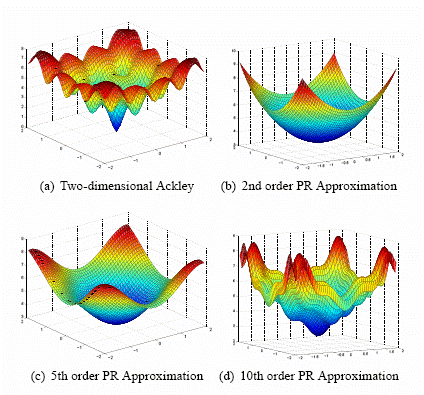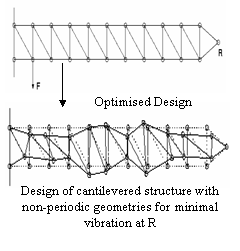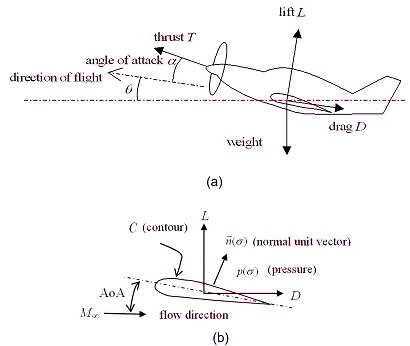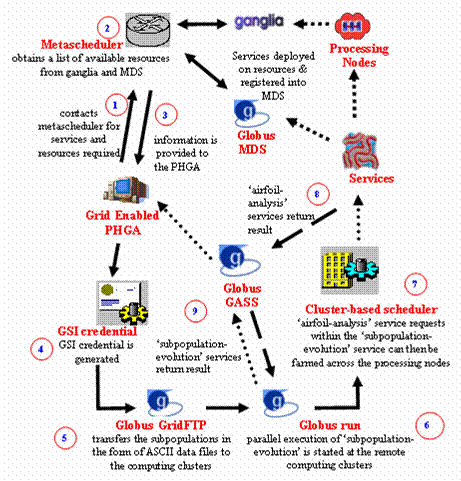Evolutionary Algorithms (EA) as a family of computational models inspired by the natural process of evolution, have been applied with a great degree of success to complex design optimization problems.
Potential solutions are encoded into a simple chromosome-like data structure, and recombination and/or mutation operators are repeatedly applied to a population of such potential solutions until a certain termination condition is reached. Their popularity lies in their ease of implementation and the ability to locate designs close to the global optimum.
However, thousands of calls to the analysis or simulation codes are often required to locate a near optimal solution in most conventional EA. Optimization problems in which the evaluation of solutions is expensive arise in a variety of contexts. The reasons for the high cost of evaluation and their effect on how many evaluations/generations can be afforded differ widely from one problem to another, as the following three examples may illustrate:
Robot Controllers
When evolving controllers for a simulated collective of robots, the fidelity of the physics simulator, the noise/stochasticity in the system, and the desire to obtain robots that are robust to rare events may all play a part in making simulation times very long.
Protein Evolution
When evolving a novel protein for a specific binding target by synthesis of proteins in vitro and their subsequent screening, thousands of proteins may be synthesised in parallel but each further "generation" will take another 12 hours to process and will also have financial implications.
Building Design
When evolving a basic conceptual design for a new building, an architect evaluating the designs will suffer fatigue after several hours and will eventually have to stop.
Solution Approaches
To circumvent the abovementioned problems, two common practices have been investigated in this project:
- Approximation Models: The use of approximation models in lieu of the exact analysis code
- Parallelization: Parallelization of the analysis code evaluations
Approximation models are used to replace calls to the computationally expensive codes as often as possible in the evolutionary search process. These approximation models are commonly known as surrogate models or metamodels. Using approximation models, the computational burden can be greatly reduced since the efforts involved in building the surrogate model and optimization using it is much lower than the standard approach of directly coupling the simulation codes with the optimizer.
Nevertheless, this approach does not always perform well when the approximation models are not managed properly. Inaccuracy of the models constructed is one of the many problems faced by most engineers and designers due to lack of data or curse of dimensionality. Hence, there is a need for methodologies to efficiently and effectively use approximation methods in evolutionary optimization in the presence of such problems.

Approximation of Computational Expensive Analysis or Simulation Models


Aerodynamic Airfoil Wing Design

Discovery of Isomers in H2O(n) Using 1st Principal Methods
One of the well-known strength of EA is also in the ability to partition the population of individuals among multiple computing nodes. Doing so allows sub-linear speedup in computation and even super-linear speedup if possible algorithmic speed-up is also considered. When applied to small scale dedicated and homogeneous computing nodes, this seems to be a very formidable solution.
In real-life situation, there are many cases where heterogeneity exists, e.g. in a Grid computing environment, which emphasizes on the seamless sharing of computing resources across laboratories and even geographical boundaries, heterogeneity of the resources in the sharing pool is inevitable. In addition to that, function evaluation time can vary in many cases, for instance, in the case where the objective function is a variable-fidelity function. In such situation a conventional parallelization without taking into account the heterogeneity of computing resources, might lead the EA to be ineffective. Hence, a suitable parallel optimization framework that fit in a heterogeneous computing environment while maintaining (or improving) the good search property of evolutionary optimization is developed.

Parallel Hierarchical Genetic Algorithm on The Grid
A Generic Surrogate-Assisted Memetic Search package is provided here for free download.
For enquiry relating to the software package, please drop me an email at asysong@ntu.edu.sg
W. M. Tan, Y. S. Ong, A. Gupta and C. K. Goh, "MultiProblem Surrogates: Transfer Evolutionary Multiobjective Optimization of Computationally Expensive Problems", IEEE Transactions on Evolutionary Computation, Vol. 23, No. 1, 2019. PDF file. *Source code Download
J. P. Luo, A. Gupta, Y. S. Ong and Z. K. Wang, "Evolutionary Optimization of Expensive Multi-objective Problems with Co-sub-Pareto Front Gaussian Process Surrogates", IEEE Transactions on Cybernetics, vol. 49, No. 5, 2019. PDF file.
B. Da, A. Gupta, Y. S. Ong, "Curbing Negative Influences Online for Seamless Transfer Evolutionary Optimization", IEEE Transactions on Cybernetics, Vol. 49, No. 12, pps. 4365-4378, 2019. PDF file. Source code available at Github.
W. M. Tan, R. Sagarna, A. Gupta, Y. S. Ong and C. K. Goh, "Knowledge Transfer through Machine Learning in Aircraft Design", IEEE Computational Intelligence Magazine, In Press, 2017. PDF file.
D. Lim, Y. S. Ong, A. Gupta, C. K. Goh and P. S. Dutta, "Towards a new Praxis in Optinformatics targeting knowledge re-use in evolutionary computation: simultaneous problem learning and optimization", Evolutionary Intelligence, Vol. 9, No. 4, pps. 203-220, 2016. PDF file.
A. Kattan, A. Agapitos, Y. S. Ong, A. A. Alghamedi and M. O'Neill, "GP Made Faster with Semantic Surrogate Modelling", Information Sciences, Vol. 355-356, pps. 169-185, 2016.
J. H. Zhong, Y. S. Ong and W. T. Cai, "Self-Learning Gene Expression Programming", IEEE Transactions on Evolutionary Computation, Vol. 20, No. 1, pp. 65-80, 2016.
A. Kattan and Y. S. Ong, "Surrogate Genetic Programming: A Semantic Aware Evolutionary Search", Information Science, Vol. 296, pps. 345-359, 2015.
M. Ellabaan, Y. S. Ong, Q. C. Nguyen and J.-L. Kuo, "Evolutionary Discovery of Transition States in Water Clusters", Journal of Theoretical and Computational Chemistry, Vol. 11, No. 05, Oct 2012. PDF file.
M. N. Le, Y. S. Ong, S. Menzel, Y. Jin and B. Sendhoff, "Evolution by Adapting Surrogates", Evolutionary Computation Journal, Accepted and In Press 2012.
S. D. Handoko, C. K. Kwoh and Y. S. Ong, "Feasibility Structure Modeling: An Effective Chaperon for Constrained Memetic Algorithms", IEEE Transactions on Evolutionary Computation, Accepted August 2009 and In Press. PDF file.
H. Soh, Y. S. Ong, Q. C. Nguyen, Q. H. Nguyen, M. S. Habibullah, T. Hung and J.-L. Kuo, "Discovering Unique, Low-Energy Pure Water Isomers: Memetic Exploration, Optimization and Landscape Analysis", IEEE Transactions on Evolutionary Computation, Vol. 14, No. 3, pp. 419-437, Jun 2010. PDF file.
D. Lim, Y. Jin, Y. S. Ong and B. Sendhoff, "Generalizing Surrogate-assisted Evolutionary Computation", IEEE Transactions on Evolutionary Computation, Vol. 14, No. 3, pp. 329-355, Jun 2010. PDF file.
Q. C. Nguyen, Y. S. Ong, H. Soh and J.-L. Kuo, "Multiscale Approach to Explore the Potential Energy Surface of Water Clusters (H2O)8 n≤8", Journal of Phys. Chem. A, Vol. 112, No. 28, pp. 6257 - 6261, 2008.
Y. S. Ong, K. Y. Lum and P. B. Nair, "Evolutionary Algorithm with Hermite Radial Basis Function Interpolants for Computationally Expensive Adjoint Solvers", Computational Optimization and Applications, Vol. 39, No. 1, January 2008, pp. 97-119. PDF file.
D. Lim, Y. S. Ong, Y. Jin and B. Sendhoff, "A Study on Metamodeling Techniques, Ensembles, and Multi-Surrogates in Evolutionary Computation", Genetic and Evolutionary Computation Conference. London, UK, pp. 1288 - 1295, 2007, ACM Press. PDF file.
Z. Z. Zhou, Y. S. Ong, M. H. Lim and B. S. Lim, "Memetic Algorithm using Multi-Surrogates for Computationally Expensive Optimization Problems", Soft Computing Journal, Vol. 11, No. 10, pp. 957-971, August 2007. PDF file.
H. Soh, Y. S. Ong, M. Salahuddin, T. Hung and B. S. Lee, "Playing in the Objective Space: Coupled Approximators for Multi-Objective Optimization", IEEE Symposium on Computational Intelligence in Multi-Criteria Decision-Making, Apr 2007. PDF file.
Z. Z. Zhou, Y. S. Ong, P. B. Nair, A. J. Keane and K. Y. Lum, "Combining Global and Local Surrogate Models to Accelerate Evolutionary Optimization", IEEE Transactions On Systems, Man and Cybernetics - Part C, Vol. 37, No. 1, Jan. 2007, pp. 66-76. PDF file.
Y. S. Ong, P. B. Nair and K. Y. Lum, "Max-Min Surrogate-Assisted Evolutionary Algorithm for Robust Aerodynamic Design", IEEE Transactions on Evolutionary Computation, Vol. 10, No. 4, pp. 392-404, August 2006. PDF file.
Y. S. Ong, Z. Z. Zong and D. Lim, "Curse and Blessing of Uncertainty in Evolutionary Algorithm Using Approximation", IEEE Congress on Evolutionary Computation, July 16-21, CEC 2006, Sheraton Vancouver Wall Centre, Vancouver, BC, Canada. PDF file.
D. Lim, Y. S. Ong, Y. Jin and B. Sendhoff, "Trusted Evolutionary Algorithm", IEEE Congress on Evolutionary Computation, July 16-21, CEC 2006, Sheraton Vancouver Wall Centre, Vancouver, BC, Canada. PDF file.
Z. Z. Zhou, Y. S. Ong, M. H. Nguyen and D. Lim, "A Study on Polynomial Regression and Gaussian Process Global Surrogate Model in Hierarchical Surrogate-Assisted Evolutionary Algorithm", Special Session on Evolutionary Computation in Dynamic and Uncertain Environments (ECiDUE'05), IEEE Congress on Evolutionary Computation, Edinburgh, United Kingdom, September 2-5, 2005. PDF file.
D. Lim, Y. S. Ong and B. S. Lee, "Inverse Multi-Objective Robust Evolutionary Design Optimization in the Presence of Uncertainty", GECCO 2005, Washington D.C. USA, June 25-29, 2005. PDF file.
Y. S. Ong, P. B. Nair, A. J. Keane and K. W. Wong, "Surrogate-Assisted Evolutionary Optimization Frameworks for High-Fidelity Engineering Design Problems", Knowledge Incorporation in Evolutionary Computation, editor: Y. Jin, Studies in Fuzziness and Soft Computing Series, Springer Verlag, pp. 307 - 331, 2004. PDF file.
Z. Z. Zhou, Y. S. Ong and P. B. Nair, "Hierarchical Surrogate-Assisted Evolutionary Optimization Framework", IEEE Congress on Evolutionary Computation, Special Session on Learning and Approximation in Design Optimization, Portland, USA, June 20-23, 2004. PDF file.
Y. S. Ong, P.B. Nair and A.J. Keane, "Evolutionary Optimization of Computationally Expensive Problems via Surrogate Modeling", American Institute of Aeronautics and Astronautics Journal, 2003, Vol. 41, No. 4, pp. 687-696. PS file.
Y. S. Ong, A.J. Keane and P.B. Nair, "Surrogate-Assisted Coevolutionary Search", 9th International Conference on Neural Information Processing, Special Session on Trends in Global Optimization, pp. 2195-2199, 18-22 November 2002. PS file.
Y. S. Ong and A.J. Keane, "A domain knowledge based search advisor for design problem solving environments", Engineering Applications of Artificial Intelligence, 2002, Vol. 15, No. 1, pp. 105-116. PS file.
Y. S. Ong and A.J. Keane, "An Automated Optimization System for Aircraft Wing Design", Seventh International Conference on Artificial Intelligence in Design, Cambridge, UK, July 2002.